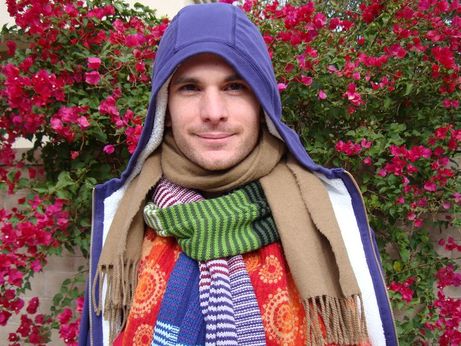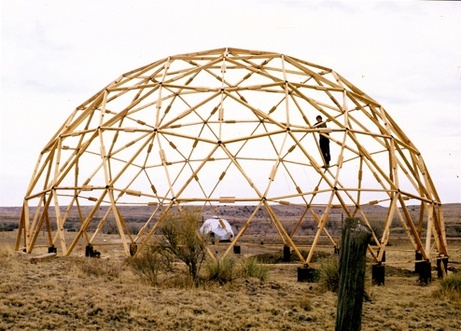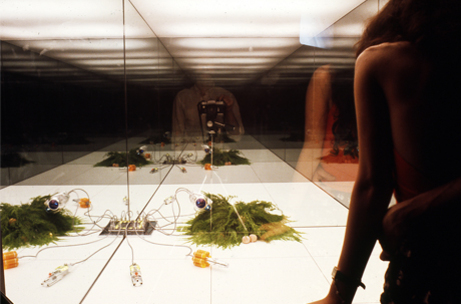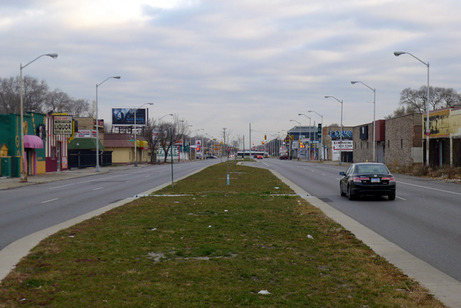Ben Vida
LAMPO PERFORMANCE SERIES
Oct 12, 2013
(8pm)
Performance
Please RSVP
Lampo and the Graham Foundation are pleased to welcome Ben Vida, who will screen a new video work and premiere a four-channel electronics piece created especially for the event. In Tztztztzt Î Í Í…Vida presents the video realization of his long form sound poem of the same title, voiced by Sara Magenheimer, Tyondai Braxton, and Vida himself. Combining images of the vocalists’ performance with synthesized translations of these vocalizations, Vida explores the relationships between video and audio inputs and outputs. By doing so, his work aims to recalibrate the viewer’s senses, drawing attention to the processes by which we receive and decode information, and as Vida writes, “the brain’s ability to create order out of multi-sensory distortions.”
Vida will also perform Damaged Particulates, a new composition for fixed and live electronics presented in four-channel-expanded stereo. Organized into eleven short movements, Damaged Particulates derives its compositional strategy from the concept of “Particulate Systems Construction,” emphasizing the morphology and spatialization of single and dual-voiced sonic particulates. Although minimal in elements, Vida’s composition is at once sonically dense, grossly visceral, and disjunctively rhythmic. Here, sound objects take on an almost physical presence within the performance space, allowing spatialization to become a compositional material and discordant sonic composites to complicate traditional compositional logic.
Ben Vida (b. 1974, Dubuque, Iowa) is an artist, improviser, composer, and writer based in Brooklyn, NY. He has been active in the international experimental music scene for the past seventeen years with a long list of collaborations, bands, and releases to his credit. He is the co-founder of the group Town and Country and has worked as a solo artist, releasing records under his own name and the moniker Bird Show on labels including PAN, Alku, Thrill Jockey, Drag City, Amish, Bottrop-Boy, Hapna, and Kranky. Vida has presented his work in the United States, Canada, the United Kingdom, Europe, Australia, South Korea, and Japan. Recent activities include performances at the Kitchen in New York with David Behrman, the debut of the Tyondai Braxton/Ben Vida Duo at the Sacrum Profamun festival in Krakow, a solo performance at Electrónica en Abril festival in Madrid, and the publication of his long form sound poem Tztztztzt Î Í Í ... by Shelter Press. Vida’s first solo exhibition, Slipping Control, opened at Audio Visual Arts in New York this past spring. He is currently an Artist in Residency at ISSUE Project Room and at the Clocktower in New York.
This performance is presented in partnership with Lampo. Founded in 1997, Lampo is a non-profit organization for experimental music, sound art, and intermedia projects. Visit www.lampo.org.

Theater Dome under construction, 1966
Drop City
Oct 03, 2013
(6pm)
Screening
Please RSVP
Drop City is the first feature-length documentary film about the artists who created a community of iconographic dwellings from the scrapheap of a wasteful society. Drop City's practices of art, architecture and sustainable living influenced a generation. Inspired by new theories and performances by Allan Kaprow, John Cage, Robert Rauschenberg, and others at Black Mountain College, the Droppers created a form of conceptual art based on performance, random interactions, and found materials. Their experimental buildings and creative practices became a model for alternative communities throughout the world. In 1966, Buckminster Fuller honored Drop City with his Dymaxion Award for "poetically economic structural accomplishments." The Droppers were at the forefront of what is now called "techno-culture"—a do-it-yourself ethos of decentralized technology. The story is told through a stunning array of film footage, photos, and interviews with Drop City's former residents, including artists, poets, inventors and activists.
Joan Grossman is visiting professor at the University of Missouri, Kansas City. She is a media artist whose work spans public radio, documentary film, and video installation. Her work has been screened and broadcast in more than twenty countries. Her award-winning film The Port of Last Resort was broadcast by HBO.
Tom McCourt is an associate professor of media at Fordham University. He is the author of Conflicting Communication Interests in America: The Case of National Public Radio (Praeger, 1999) and coauthor (with Patrick Burkart) of Digital Music Wars: Ownership and Control of the Celestial Jukebox (Rowman and Littlefield, 2006). He first encountered the story of Drop City more than twenty years ago and has researched its history and significance for several years.
Print Source: 7th Art Releasing
Related Links
Drop City
http://grahamfoundation.org/grantees/207-drop-city

Microevent/Microenvironment, 1972. Photograph by Cristiano Toraldo di Francia, courtesy of Emilio Ambasz.
Opening Reception: Environments and Counter Environments
Sep 18, 2013
(6pm)
Please RSVP
Please join us to celebrate the opening of Environments and Counter Environments. "Italy: The New Domestic Landscape,” MoMA, 1972 with curators Luca Molinari, Peter Lang, and Mark Wasiuta.
6PM - Discussion with exhibition curators
6:30-8:30PM - Opening Reception
For more information on the exhibition, Environments and Counter Environments. "Italy: The New Domestic Landscape,” MoMA, 1972, click here.

Livernois Corridor - Detroit's Next Hot Spot?
Catalytic Converter
Monica Chadha and Virginia Stanard
Aug 22, 2013
(6pm)
Talk
Please RSVP
The nature of community development has evolved beyond the creation of long-term plans. Please join us as Monica Chadha and Virginia Stanard discuss how they create catalysts for communities through immediate actions and multidisciplinary partnerships in their work at Impact Detroit and in other neighborhood initiatives. Following the talk, Where If Not Us exhibition participant Michael Rios will start a brief discussion.
Monica Chadha is an architect and an Adjunct Assistant Professor at Illinois Institute of Technology. Her practice addresses community revitalization. In 2009, Chadha co-founded Converge:Exchange and she is currently developing Impact Detroit:, a partnership with the Detroit Collaborative Design Center (University of Detroit Mercy). Chadha was previously a Project Manager at Studio Gang Architects and Ross Barney Architects. At IIT, Chadha has led a community engagement design studio focused on the redevelopment of Bronzeville (Chicago) and several core studios. She has presented at several conferences and has most recently been published in Reveal, Princeton Architectural Press 2010. Chadha received her Masters of Architecture degree from the University of Illinois at Chicago, and a Bachelor of Environmental Studies in Architecture from the University of Waterloo, Canada.
Virginia Stanard is the Director of Urban Design at the Detroit Collaborative Design Center and Co-Director of the Master of Community Development program at the University of Detroit Mercy. She holds master’s degrees in Architecture and Urban Design from the University of Michigan and a bachelor’s degree in Architecture from the University of Virginia. Through practice and teaching, she advocates community development through the collaborative design process. At the DCDC, Virginia has developed economic and physical revitalization strategies at a range of scales and for a range of clients - including cities, philanthropic foundations, neighborhood groups, and developers. Recent projects include a greenway and development plan for daylighting the Bloody Run Creek on Detroit’s east side. Other projects include a development plan for Detroit’s Paradise Valley Cultural District, planning for Detroit Future City (formerly the Detroit Works Project Long Term Planning initiative), and revitalization strategies for Detroit’s 48217 and Woodbridge neighborhoods.
Impact Detroit, an initiative of the Detroit Collaborative Design Center (DCDC) at the University of Detroit Mercy School of Architecture, was launched in 2011 to support Detroit’s capacity for community development. It is an initiative that provides expertise, knowledge, and resources to help implement community-driven strategies as they relate to the built environment. Impact Detroit will form a collective hub leveraging the interdisciplinary expertise of professionals, local organizations, emerging leaders and community stakeholders to foster collaboration and realize local projects.
Converge: Exchange is a platform for communities, activists and practitioners to share innovative design strategies in local economies and for the built environment.
Michael Rios is an associate professor in the Department of Environmental Design and Chair of the Community Development Graduate Group at UC Davis. Formerly, Rios was the director of the Hamer Center for Community Design and the president of the Association of Community Design. Projects visited include: Organizing Public Interest Design, 1997-1999, revisited 2010 (Union Point Park, Oakland); A Public Transport Hub Becomes a Zócalo for Multiple Publics, 1995-1998, revisited 2010(Plaza del Colibri, San Francisco).
For more information on the exhibition, Where If Not Us? Participatory Design and Its Radical Approaches, click here.

The Pruitt-Igoe Myth: An Urban History
Chad Friedrichs
Aug 07, 2013
(6pm)
Screening
Please RSVP
The Pruitt-Igoe Myth tells the story of the wholesale changes that took place in the American city in the decades after World War II, through the lens of the infamous Pruitt-Igoe housing development in St. Louis. Destroyed in a dramatic and highly publicized implosion, the Pruitt-Igoe public housing complex has become a widespread symbol of failure amongst architects, politicians, and policy makers. At the film's historical center is an analysis of the massive impact of the 1949 Housing Act, which resulted in American cities being emptied of their residents, business and industry. And yet, despite its complex history, Pruitt-Igoe has often been stereotyped, with help from a world-famous image of its implosion, and used as an argument against modernist architecture or public assistance programs. The Pruitt-Igoe Myth seeks to set the historical record straight, to examine the interests in Pruitt-Igoe's creation, to re-evaluate the rumors and the stigma, and to implode the myth.
Chad Freidrichs has produced and directed two feature-length documentary films through his production company Unicorn Stencil Documentary Films. The first Jandek on Corwood (2003), documented the mystery and cult following of an underground musician. Its second film First Impersonator (2006), followed presidential look-alikes as they navigated the 2004 election and chronicled the rise and fall of famed John F. Kennedy impersonator Vaughn Meader. Freidrichs's films have screened at fifty film festivals including South by Southwest and Silverdocs, and played in seventy-five cities. In addition to making documentary films, he is on the faculty of Stephens College in Columbia, Missouri, where he teaches courses in advanced film production and film criticism. He has also made numerous corporate videos and more than 1,000 commercials.
Related Links
The Pruitt-Igoe Myth: An Urban History
http://grahamfoundation.org/grantees/205-the-pruitt-igoe-myth-an-urban-history






 PREVIOUS POSTS
PREVIOUS POSTS